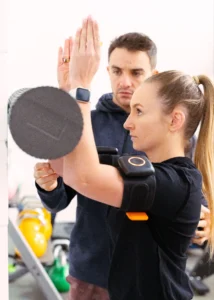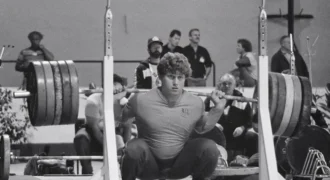What is Blood Flow Restriction (BFR)?
Blood Flow Restriction (BFR) training is a science-backed method that helps people increase strength, muscle mass, and endurance using lighter weights and in significantly less time. BFR works by partially restricting blood flow to the working muscles during low-load, low-intensity exercise. This restriction mimics the metabolic stress and muscular environment typically created by high-load, high-intensity training without the need for heavy lifting. BFR produces increases in muscle mass, strength, and endurance similar to high-load, high-intensity training but it does it without the joint stresses and heavy weights. 
Image: Athlete wearing BFR cuffs in rehab
Originally developed in the 1960s, BFR has advanced dramatically with modern technology, making it safer, more precise, and widely accessible. Today, it’s used by physical therapists, athletes, fitness professionals, and everyday individuals alike. BFR is especially beneficial for prehabilitation, rehabilitation, and recovery, but it also fits seamlessly into general strength, hypertrophy, and longevity programs. It’s ideal for training while traveling, minimizing joint stress, and working around injuries. In recent years, BFR has gained popularity as a powerful longevity hack offering a way to maintain and improve muscle health and strength while reducing wear and tear on the body.

Image: Using a smart phone to inflate BFR units to different limb occlusion pressures
For those recovering from surgery or managing conditions that prevent heavy lifting, BFR offers a way to safely stimulate muscle growth and strength gains. It can also be used passively to support recovery, reduce muscle atrophy, and enhance circulation. Put the cuffs on and kick back.

Image: Athlete Performing a Single Leg RDL with BFR Cuffs
Whether you’re an athlete looking to maximize gains, a patient in rehab, or someone seeking a joint-friendly training method, BFR offers a smart, efficient, and research-supported solution to get stronger without going heavy.
Whether you’re looking to maximize gains, in rehab, or someone seeking a joint-friendly training method, BFR offers a smart, efficient, and research-supported solution to get stronger without going heavy, says Michael MacPherson
Share on X
The Benefits of Blood Flow Restriction (BFR)
The benefits of blood flow restriction (BFR) training include increases in muscle strength, size, and endurance, improved cardiovascular function, and even improvements in learning, memory, and cognitive function. BFR increases testosterone, growth hormone, insulin-like growth factor, brain-derived neurotrophic factor (BDNF), and vascular endothelial growth factor (VEGF) by creating a muscular environment that mimics the environment created during high-load, high-intensity training. BFR creates a low-oxygen muscular environment that’s both mechanically and metabolically stressful.
How does Blood Flow Restriction (BFR) Work?
The benefits of BFR come from the partial restriction of arterial inflow and the occlusion (full restriction) of venous outflow. The partial restriction of arterial inflow decreases the amount of blood entering the limb and the occlusion of venous outflow prevents any blood from leaving the limb. The partial restriction of arterial inflow creates a hypoxic or low-oxygen environment and the occlusion of venous outflow creates a mechanically and metabolically stressful environment. Both the partial restriction of arterial inflow and the occlusion of venous outflow contribute to the benefits of BFR but before we dive deeper into BFR, we have to refresh some vocabulary so we are all speaking the same language.
Muscle Fibers
Current science states we are composed of three different types of muscle fibers, type 1, type 2A, and type 2X but we are going to keep it simple and split them into two groups, Type 1 muscle fibers and type 2 muscle fibers.
Type 1, Slow Twitch Muscle Fibers
Type 1 muscle fibers are “slow twitch” muscle fibers. They contract slowly so they produce less force compared to type 2 fibers. Type 1 muscle fibers are aerobic and use oxygen to contract. Using oxygen reduces the production of metabolic by-products decreasing fatigue. Type 1 fibers fatigue slower than type 2. Type 1 fibers are low-load, endurance muscles. They are used to maintain posture and to perform tasks that do not require large amounts of force. Elite marathon runners and cross-country skiers would be predominantly type 1 muscle fibers.
Type 2 Fast Twitch Muscle Fibers
Type 2 muscle fibers are “fast twitch” muscle fibers. They contract quickly and are capable of producing large amounts of force. Over time type 2 muscle fibers can increase in size (hypertrophy) to meet the force demands of a task. Type 2 fibers are more likely to grow than type 1 fibers. Type 2 muscle fibers are also anaerobic so they do not use oxygen to contract. By not using oxygen, type 2 fibers produce more metabolic by-products (than type 1) and fatigue quicker. Elite sprinters and weightlifters are predominantly type 2 muscle fibers.
The Henneman Size Principle Theory
The Henneman size principle theory states that muscle fibers are used based on the amount of force needed to complete a task. Type 1 muscle fibers are used until they can’t be. The body likes to use type 1 muscle fibers because they do not create as many metabolic by-products as type 2 fibers. Low loads do not require great amounts of force so the brain recruits and uses type 1 muscle fibers. When a load increases and a large amount of force is required, the brain recruits and begins using more type 2 muscle fibers. As more type 2 muscle fibers are used, the environment within the limb changes.
What Happens During Traditional Strength Training?
During traditional high-load, high-intensity strength training, forceful type 2 muscle contractions compress blood vessels, reducing oxygen and forcing blood into the muscle cells causing them to swell. The reduction of oxygen triggers the production of hypoxia-inducible factors (HIFs), heat shock proteins (HSPs), and metabolic by-products. Reduced oxygen levels also increase recruitment of type 2 muscle fibers.The blood being forced into the muscle cells creates a mechanical stress known as cellular swelling aka a “pump”.
What Happens During BFR Training?
During low-load,low-intensity BFR training a hypoxic environment that is mechanically and metabolically stressful is created through the use of AirBands BFR. During blood flow restriction (BFR) training a cuff is applied to the top of a limb(s) (AirBands can be placed at the top of an arm or arms or at the most proximal portion of a leg or legs but never on an arm and a leg at the same time). An individualized limb occlusion pressure (LOP) is calculated and then the cuff is inflated. When the cuff is inflated, arterial inflow is partially restricted, and venous outflow is occluded (complete restriction). The restriction of arterial inflow creates a hypoxic environment in the occluded limb that alters the way muscle fibers are recruited. The hypoxic environment limits the use of type 1 muscle fibers and increases type 2 muscle fiber recruitment. The occlusion of venous outflow creates mechanical and metabolic stress.
Hypoxia triggers the production of hypoxia-inducible factor-1 (HIF-1ɑ), and heat shock proteins (HSPs). HIF-1ɑ is a master regulator in the human body. When a low oxygen environment is detected, HIF-1ɑ upregulates brain derived neurotrophic factor (BDNF), vascular endothelial growth factor (VEGF), glucose transporters and Erythropoietin (EPO). BDNF is a neuroprotective protein that promotes learning, memory, and brain cell survival. VEGF stimulates the growth of new blood vessels (angiogenesis). Glucose transporters help shuttle glucose out of the blood and into the muscles, while EPO stimulates the production of red blood cells. Heat shock proteins (HSPs) are longevity proteins. They protect against neurodegeneration, cardiovascular disease, and muscle atrophy. HSPs assist in protecting cellular structures and ensure that proteins continue to do their jobs appropriately.
The occlusion of venous outflow creates mechanical and metabolic stress. The cuff prevents blood from leaving the occluded limb. Metabolite rich blood is unable to escape the occluded limb leading to an anabolic response and increased recruitment of type 2 muscle fibers. The metabolically stressful environment of the occluded limb upregulates the production of testosterone, growth hormone, and insulin-like growth factor. The increase in anabolic hormones leads to increases in muscle strength, size, recovery, and healing. Healing is also accelerated in bone and in connective tissues like ligaments and tendons.
As blood pools in the occluded limb, it enters the muscle cells and causes them to swell. The cellular swelling stretches and stresses the muscle cell triggering the cell membrane to send a growth signal to the nucleus. The membrane lets the nucleus know that it must increase in size to deal with the cellular swelling and in response the nucleus further upregulates testosterone, growth hormone, insulin-like growth factor, and muscle protein synthesis.
The hypoxic, mechanically and metabolically stressful environment created by the occlusion mimics the environment created by high-load, high-intensity training. The environment triggers the production of anabolic hormones that increase muscle strength, mass, and endurance and enhance healing and recovery.
What is LOP?
Once the AirBands BFR cuff has been placed at the top of the limb, the app will calibrate an individual limb occlusion pressure (LOP). Limb occlusion pressure (LOP) is the minimum pressure needed to fully occlude arterial inflow. AirBands will calculate an individualized LOP in 30 seconds and provide that pressure in mmHg. No need for a doppler or manual calculations. Calculating an individualized LOP ensures both safety and effectiveness. Everyone has unique limb sizes, blood pressure, and vascular anatomy, so using a standardized pressure can either under-restrict (reducing effectiveness) or over-restrict (increasing discomfort and risk). Once an individualized LOP has been determined, the cuff is inflated to the BFR “sweet spot” 40-80% LOP and training begins.

Image: Customizing workout settings for BFR cuffs on a smart phone
Applying BFR
Here are three ways to use BFR training depending on what your goals are.
BFR Strength Training
Numerous studies support the safety and efficacy of blood flow restriction (BFR) training but there are certain guidelines that we must be adhered to. When it comes to increasing muscle strength and size we want to inflate the cuffs to 40-80% LOP and perform 3-6 exercises. We want to perform 3 sets of 15 repetitions for each exercise at around 20-40% of our 1RM. We can deflate the cuffs in between exercises or we can deflate the upper body cuffs every 15 minutes and the lower body cuffs every 20 minutes. The maximum recommended amount of continuous occlusion for the upper body is 15 minutes and 20 minutes for the lower body. When we hit those limits, we’ll want to deflate the cuffs for 2-3 minutes before reinflating and finishing our workout. As always, it is vital that we use proper form and technique.

Image: Guide to how to use BFR for strength and hypertrophy
Aerobic BFR
The guidelines for aerobic BFR are similar to BFR strength training. We’ll want to inflate our AirBands BFR cuffs to 40-80% LOP and pedal, row, or walk at a low-to-moderate intensity for 10-20 minutes. The benefits of aerobic BFR include increases in muscle strength, mass and endurance. Aerobic BFR is often used as an active recovery solution for many athletes.

Image: Guide to how to use BFR for aerobic capacity
Passive BFR
Passive BFR is blood flow restriction without exercise. Passive BFR is used early post-operatively to reduce atrophy. It’s also used to enhance recovery and healing. Passive BFR uses higher levels of occlusion (70-100%) and occlusion cycles. Current literature supports the use of two cuffs for recovery instead of one. To perform a passive BFR recovery cycle, inflate your AirBands BFR cuffs to 70-100% LOP, hold that pressure for 5-minutes and then deflate for 1-5 minutes. The deflation period is based on tolerance but it must be at least 1 minute long and no longer than 5 minutes. We then reinflate the cuffs to the same pressure for two more cycles of pressure for 5-minutes and deflation for 1-5 minutes. Passive BFR increases testosterone, growth hormone, insulin-like growth factor, nitric oxide, brain-derived neurotrophic factor and vascular endothelial growth factor without exercise. 
Image: Guide to how to use BFR for recovery and healing
Conclusion
Blood Flow Restriction (BFR) training bridges the gap between science and everyday performance. Grounded in research and trusted by clinicians, coaches, and athletes, BFR delivers the benefits of high-intensity training with lighter loads and less joint stress. By creating a controlled, low-oxygen environment, it safely stimulates increases in muscle strength, size and endurance making it just as effective in rehab as it is in peak performance. Whether you’re rebuilding after injury, training for competition, or simply looking to stay strong for life, BFR offers a smarter, safer, and science-backed way to get stronger without going heavy.
BFR offers a smarter, safer, and science-backed way to get stronger without going heavy, says Michael MacPherson
Share on X
The post The Future of Fitness: Why Blood Flow Restriction Training Is Changing Rehab, Recovery, and Resistance Training appeared first on SimpliFaster.






